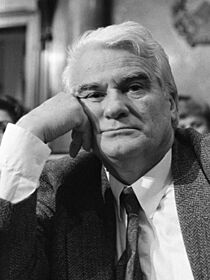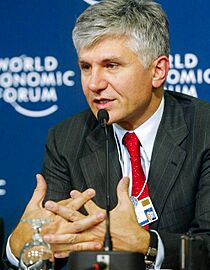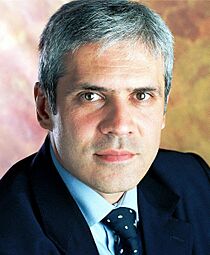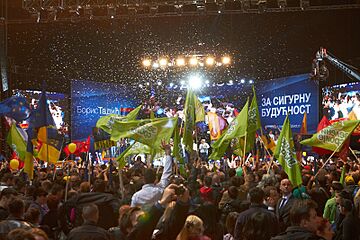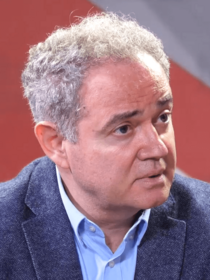Democratic Party (Serbia) facts for kids
The Democratic Party (known as DS) is a political party in Serbia. It's a social democratic party, which means it believes in fairness, equality, and helping people in society. Srđan Milivojević became the party's leader in 2024. People sometimes call the party the žuti (yellows) because yellow is one of its main colors.
Quick facts for kids
Democratic Party
Демократска странка
|
|
|---|---|
| Abbreviation | DS |
| President | Srđan Milivojević |
| Deputy President | Dragana Rakić |
| Vice-Presidents |
|
| Parliamentary leader | Srđan Milivojević |
| Founder | The Founding Committee of the Democratic Party |
| Founded | 3 February 1990 |
| Registered | 27 July 1990 |
| Headquarters | Nušićeva 6/II, Belgrade |
| Newspaper | Bedem |
| Youth wing | Democratic Youth |
| Women's wing | Women's Forum |
| Ideology |
|
| Political position | Centre-left |
| European affiliation | Party of European Socialists (associate) |
| International affiliation |
|
| Parliamentary group | Democratic Party |
| Colours |
|
| National Assembly |
8 / 250
|
| Assembly of Vojvodina |
4 / 120
|
| City Assembly of Belgrade |
2 / 110
|
| Party flag | |
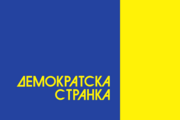 |
|
The DS was started in 1990 by a group of smart people who wanted to bring back the old Democratic Party from the time of the Kingdom of Yugoslavia. Dragoljub Mićunović was the first president of DS. Under his leadership, the party won seats in the Serbian parliament and joined protests against the government of Slobodan Milošević.
In 1994, Zoran Đinđić became the new president of DS. He helped the party join a group called "Together." They protested in 1996 and 1997 when election results were changed. Later, DS was part of the Democratic Opposition of Serbia (DOS). This group won the election in 2000, which led to Milošević leaving power.
DS took power in Serbia after winning the December 2000 elections, and Đinđić became the prime minister. Sadly, Đinđić was killed in March 2003. After him, Boris Tadić became the president of DS. Tadić also became the president of Serbia in 2004. DS was in power with other parties from 2007 to 2012. In 2012, the party lost to the Serbian Progressive Party and went into opposition.
Since then, DS has had several leaders, including Dragan Đilas, Bojan Pajtić, Dragan Šutanovac, and Zoran Lutovac. The party has joined different groups of opposition parties. In 2020, DS boycotted the parliamentary election, which caused some disagreements within the party. However, they returned to the National Assembly in the 2022 election. In late 2024, Srđan Milivojević became the new leader.
DS started as a party that welcomed many different ideas. It supported a market economy (where businesses are mostly private) and workers' rights. Over time, it became more focused on being pro-European and is now seen as a centre-left party. This means it supports social programs and fairness for everyone. People who support DS often have a good education, are open to different ideas, and are against strong, controlling governments. DS is part of international groups like the Party of European Socialists.
Contents
History of the Democratic Party
How the Party Started
On December 11, 1989, a group of smart people, including writers and directors, announced they were bringing back the Democratic Party. This party had existed in the Kingdom of Yugoslavia until 1945. The people who started it wanted to "re-found" it, not create a brand new party.
In 1989, Yugoslavia was a one-party state, meaning only one political party was allowed. So, DS became the first non-communist opposition party. In January 1990, the ruling party in Yugoslavia started to break apart. This led to different republics, including Serbia, allowing many political parties. DS held its first meeting on February 3, 1990, in Belgrade. Dragoljub Mićunović became the first president. The party was officially registered in Serbia on July 27, 1990.
Early Years (1990–1993)
After it started, DS began publishing its own newspaper called Demokratija (Democracy). It also created a youth group called Democratic Youth. In September 1990, Mićunović was re-elected president. DS decided to take part in the 1990 Serbian parliamentary election. Even though they won 7% of the votes, they only got 7 seats in the parliament. This was because of the election system at the time.
In March 1991, DS joined other parties in big protests in Belgrade. They wanted changes to the state television. These protests led to some changes, including the resignation of the TV director.
After Yugoslavia started to break up in 1992, Serbia became part of the Federal Republic of Yugoslavia. DS decided not to take part in the May 1992 federal elections, saying they weren't fair. Instead, they organized more protests. Some members left the party because of disagreements, forming new parties like the Democratic Party of Serbia (DSS).
DS did take part in the December 1992 federal election and won 5 seats. They also joined the government led by Milan Panić. In the Serbian elections held at the same time, DS won 6 seats.
In 1993, Zoran Đinđić became more important in the party. He led DS in the 1993 parliamentary election. He visited many places in Serbia during the campaign. DS won 29 seats, a big increase. However, DS remained in opposition.
Đinđić's Leadership (1994–2000)
On January 25, 1994, Đinđić was elected president of DS. Mićunović left his position. Đinđić changed how the party worked, making it more active. In 1996, Mićunović left DS and started his own party.
In September 1996, DS formed a group called "Together" with other parties to take part in federal and local elections. This group won local elections in important cities like Belgrade. However, the election results were cancelled by the Electoral Commission. This led to huge protests in 1996 and 1997. After the protests, Đinđić became the mayor of Belgrade. But in September 1997, he was removed from office.
The "Together" group broke up before the 1997 elections. DS decided to boycott these elections. In 1998, DS joined a group called the Alliance for Change. This group later became part of a bigger alliance, the Democratic Opposition of Serbia (DOS), in January 2000.
In February 2000, Đinđić was re-elected as party president. In the 2000 federal elections, DOS chose Vojislav Koštunica as their candidate for president of Yugoslavia. He won in the first round. However, Milošević refused to accept the results. This led to massive protests on October 5, 2000, which resulted in Milošević being removed from power. Two days later, the real election results were published, confirming Koštunica's win. In December 2000, DOS won 176 out of 250 seats in the Serbian parliament.
After Milošević (2001–2004)
In January 2001, Đinđić became the prime minister of Serbia. After Milošević was sent to a special court in June 2001, some members of other parties left Đinđić's government. DS also changed its goals, moving more towards the left side of politics.
In September 2002, DS supported Miroljub Labus for president. He came second, but the election was cancelled because not enough people voted. Another election was held in December 2002, but it was also cancelled for the same reason. A third election was planned for November 2003.
Đinđić was against organized crime. He survived an attempt on his life in February 2003. One month later, on March 12, 2003, Đinđić was killed by a member of a criminal group.
Zoran Živković took over as prime minister and acting president of DS. In the 2003 presidential election, DS supported Mićunović, but he came second, and the election was cancelled again due to low voter turnout. Živković decided to call for new parliamentary elections in December 2003. DS joined a group of parties for this election and won 22 seats for itself, putting them in opposition.
In February 2004, Boris Tadić was elected president of DS. Mićunović's party later joined DS. In June 2004, Tadić ran for president of Serbia. He won in the second round with 53% of the votes. In December 2004, Tadić removed Čedomir Jovanović from the party for breaking party rules. Jovanović later formed his own party.
Tadić's Time (2005–2012)
During Tadić's time as president of Serbia, he apologized to Bosnia and Herzegovina and Croatia for Serbia's role in the wars in Yugoslavia. He also worked to improve Serbia's relationships with Western countries. He was re-elected as DS president in 2006.
In January 2007, new parliamentary elections were held. DS campaigned on continuing Đinđić's work and fighting corruption. DS won over 900,000 votes and formed a government with other parties. Tadić was re-elected president of Serbia in January 2008.
Soon after, Kosovo declared its independence from Serbia. This caused problems in the government. Tadić called for new parliamentary elections in May 2008. Before the election, DS formed a group called "For a European Serbia." This group won the most seats, and DS itself won 64 seats. After the election, DS formed a government with the Socialist Party of Serbia (SPS). They agreed to work on Serbia joining the European Union, fighting crime, and helping people in need. Mirko Cvetković, who was close to DS, became prime minister.
The DS-led government faced challenges like the arrest of Radovan Karadžić, Kosovo's independence, and a big financial crisis. In 2011, the Serbian Progressive Party (SNS) organized protests, asking for new elections. Tadić called for elections in May 2012. He also announced he would resign as president, so presidential elections would be held at the same time. DS led a group called "Choice for a Better Life." They focused on economic recovery and attracting foreign money. This group came second, and DS won 49 seats. In the presidential election, Tadić lost to Tomislav Nikolić.
After the 2012 elections, SPS formed a government with SNS, and DS went into opposition. Dragan Đilas became the new president of DS in November 2012. Some members left the party during this time.
Challenges and Changes (2013–2017)
In January 2013, some members were removed from DS, and they formed new political groups. DS's public support also dropped. In September 2013, Đilas was removed as mayor of Belgrade. This led to disagreements within DS, and some members wanted Đilas to resign as party president. He survived a vote of no confidence.
Boris Tadić left DS in January 2014 because he disagreed with the party's leaders. He then started his own new party. DS took part in the 2014 parliamentary election with other parties, but they only won 17 seats for DS.
After the elections, Bojan Pajtić was elected president of DS in May 2014. Đilas then left the party. In March 2016, new parliamentary elections were called. DS formed a group called "For a Just Serbia" and won 12 seats. After this election, Dragan Šutanovac became the new president of DS in September 2016.
In January 2017, DS decided to support Saša Janković in the presidential election instead of having their own candidate. Janković came second but later formed his own party. For the 2018 Belgrade City Assembly election, DS wanted opposition parties to join forces.
Lutovac's Leadership (2018–2024)
In January 2018, DS joined with Tadić's party for the Belgrade election, but they didn't win any seats. This led to Šutanovac resigning. In June 2018, Zoran Lutovac was elected president of DS. He said DS needed to get organized and work with other opposition groups.
In September 2018, DS joined a nationwide group called the Alliance for Serbia. In January 2019, DS announced it would boycott sessions of the parliament, saying they weren't fair. They also signed an agreement to boycott the 2020 parliamentary election if conditions weren't fair.
During the COVID-19 pandemic, the party's planned meeting was postponed. Some members disagreed with the boycott and tried to hold their own leadership election. Lutovac said this was an attempt to break up DS. He removed some members from the party. The government later confirmed Lutovac as the official president of DS.
The Alliance for Serbia broke up. DS then joined a new group called United for the Victory of Serbia for the 2022 general election. They nominated Zdravko Ponoš for president. This group won 14% of the votes in the parliamentary election, and DS won 10 seats. Ponoš came second in the presidential election. After the election, the group broke up. Lutovac was elected vice-president of the National Assembly.
After the tragic shootings in May 2023, DS was one of the parties that organized large protests. In October 2023, DS joined the "Serbia Against Violence" group. This group ran in the parliamentary, provincial, and Belgrade city elections in December 2023. They won 65 seats in parliament, with 8 going to DS. After the elections, they organized more protests. A new election for the Belgrade City Assembly was called for June 2024. DS was neutral about participating. The "Serbia Against Violence" group split, and DS joined a new group called "We Choose Belgrade," which won 14 seats in Belgrade, with 2 for DS.
Milivojević's Leadership (2024–Present)
In December 2024, DS held new leadership elections. Srđan Milivojević won and became the new president. Soon after, he started a plan to bring together other progressive political parties. The "Together" party joined DS on December 27.
What the Democratic Party Believes In
Early Ideas (Mićunović and Đinđić)
When DS first started, it had many different ideas and people with different views. It included people who believed in liberalism (focusing on individual rights and freedoms) and others who wanted a stronger focus on Serbian identity.
DS supported a mixed economy, which means a balance between private businesses and some government involvement. They wanted to create a modern market economy and connect Serbia with Europe. They believed in a democratic system with many parties and human rights. For Yugoslavia, they wanted a system where different parts of the country had more power and where ethnic conflicts would decrease.
Some experts said DS was a centre-right party when it started because it supported a free market and a smaller role for the government. Others described it as liberal-democratic. After 1993, DS used less strong anti-communist language.
Under Đinđić, DS became more practical and flexible. It became the main party against Milošević after 1998. Đinđić was seen as someone who wanted reforms and good relations with Western countries. DS supported selling state-owned companies to private owners. However, they also supported workers' rights, social security, and fighting unemployment. They wanted Serbia to be closer to Western countries and rejoin the international community.
Tadić's Ideas
After Đinđić's death, DS tried to become more of a social democratic party, but some felt it didn't fully commit. Instead, it moved towards social liberalism, which combines social justice with individual freedoms. Other experts described DS under Tadić as a centrist party, linked to liberalism.
Tadić himself said he was a liberal. He was popular with business people because he supported Serbia joining the European Union. DS became the main party supporting Europe and liberal ideas in Serbia. They also promoted selling state-owned companies to help Serbia's economy grow.
DS under Tadić was seen as supporting international cooperation and Western countries. They believed that the issue of Kosovo should be solved through talks. Tadić tried to balance relations with different countries. Just before the 2012 elections, Serbia became a candidate for European Union membership.
To attract voters from different ethnic groups, DS supported regionalism, giving more power to different regions. They also wanted to improve living standards and develop all parts of Serbia.
Ideas After Tadić
After 2012, DS moved even more to the left and started to call itself a social democratic party. Experts now agree it is a social democratic party and is on the centre-left of politics.
DS has been in opposition to the current government since 2012. They have criticized the government's approach to Kosovo, though they supported an agreement in 2013. In 2023, DS opposed a new agreement on Kosovo, saying it didn't protect Serbia's interests.
When Dragan Đilas led DS in 2014, he promised free textbooks for students, full pay for pregnant women, higher wages for healthcare workers, and help for older people. DS is also against mining jadarite (a mineral) in Serbia and signed an agreement to ban lithium mining in 2021.
DS says it supports the most progressive ideas. It wants to protect workers, minority groups, and the environment. It also supports guaranteed rights to healthcare, education, and pensions. In 2014, an organization that supports LGBT community rights said DS was the most positive party towards the LGBT community. DS has spoken out against violence towards the LGBT community and supported the EuroPride event in Belgrade in 2022.
How the Democratic Party is Organized
As of December 2024, DS is led by Srđan Milivojević. Dragana Rakić is the deputy president, and there are several vice-presidents. Milivojević also leads the party's group in the National Assembly. The party's main office is in Belgrade.
From 1990 to 1998, DS published a newspaper called Demokratija. Since 2021, they have published Bedem. The party has a youth group called Democratic Youth and a women's group called Women's Forum. Anyone who is an adult citizen of Serbia and not a member of another party can join DS. In 2013, DS reported having almost 200,000 members.
DS has branches in cities, towns, and local areas, as well as a special branch in Vojvodina. The party has different parts that help it run, like a main board, a presidency, and various committees.
Many political parties have been formed by people who left DS. These include the Democratic Centre, DSS, G17 Plus, LDP, Nova, NDS, LS, SLS, SDS, and ZZS.
Working with Other Countries
DS has been a member of the Socialist International since 2003. In 2006, it became a partner member of the Party of European Socialists. DS is also connected with the Progressive Alliance. Its youth group is a member of the Young European Socialists.
DS leaders have met with politicians from other countries to discuss economic relations and cooperation. For example, in 2014, Bojan Pajtić met with officials from China and other European parties. In 2017, Dragan Šutanovac met with the leader of the Social Democratic Union of Macedonia to talk about cooperation in the region and joining the European Union.
Leaders of the Democratic Party
| # | President | Birth–Death | Term start | Term end | ||
|---|---|---|---|---|---|---|
| 1 | Dragoljub Mićunović |  |
1930– | 3 February 1990 | 25 January 1994 | |
| 2 | Zoran Đinđić |  |
1952–2003 | 25 January 1994 | 12 March 2003 (assassinated) |
|
| – | Zoran Živković (acting) |
 |
1960– | 12 March 2003 | 22 February 2004 | |
| 3 | Boris Tadić |  |
1958– | 22 February 2004 | 25 November 2012 | |
| 4 | Dragan Đilas |  |
1967– | 25 November 2012 | 31 May 2014 | |
| 5 | Bojan Pajtić |  |
1970– | 31 May 2014 | 24 September 2016 | |
| 6 | Dragan Šutanovac |  |
1968– | 24 September 2016 | 2 June 2018 | |
| 7 | Zoran Lutovac |  |
1964– | 2 June 2018 | 14 December 2024 | |
| 8 | Srđan Milivojević |  |
1965– | 14 December 2024 | Incumbent | |
Timeline of Leaders

Election Results
Parliamentary Elections
| Year | Leader | Popular vote | % of popular vote | # | # of seats | Seat change | Coalition | Status | |
|---|---|---|---|---|---|---|---|---|---|
| 1990 | Dragoljub Mićunović | 374,887 | 7.78% |
7 / 250
|
– | Opposition | |||
| 1992 | 196,347 | 4.42% |
6 / 250
|
– | Opposition | ||||
| 1993 | 497,582 | 12.06% |
29 / 250
|
– | Opposition | ||||
| 1997 | Zoran Đinđić | Did not participate |
0 / 250
|
– | Extra-parliamentary | ||||
| 2000 | 2,402,387 | 65.69% |
45 / 250
|
DOS | Government | ||||
| 2003 | Boris Tadić | 481,249 | 12.75% |
22 / 250
|
DS–GSS–SDU–LZS | Opposition | |||
| 2007 | 915,854 | 23.08% |
60 / 250
|
DS–SDP–DSHV | Government | ||||
| 2008 | 1,590,200 | 39.25% |
64 / 250
|
ZES | Government | ||||
| 2012 | 863,294 | 23.09% |
49 / 250
|
IZBŽ | Opposition | ||||
| 2014 | Dragan Đilas | 216,634 | 6.23% |
17 / 250
|
DS–DSHV–Nova–BS | Opposition | |||
| 2016 | Bojan Pajtić | 227,589 | 6.20% |
12 / 250
|
DS–Nova–DSHV–ZZS–ZZŠ | Opposition | |||
| 2020 | Zoran Lutovac | Did not participate |
0 / 250
|
SZS | Extra-parliamentary | ||||
| 2022 | 520,469 | 14.09% |
10 / 250
|
UZPS | Opposition | ||||
| 2023 | 902,450 | 24.32% |
8 / 250
|
SPN | Opposition | ||||

Presidential Elections
| Year | Candidate | 1st round popular vote | % of popular vote | 2nd round popular vote | % of popular vote | Notes | |||
|---|---|---|---|---|---|---|---|---|---|
| 1990 | Did not participate | – | |||||||
| 1992 | Milan Panić | 2nd | 1,516,693 | 34.65% | N/A | — | — | Supported Panić | |
| Sep 1997 | Did not participate | Election cancelled due to low turnout | – | ||||||
| Dec 1997 | Did not participate | – | |||||||
| Sep–Oct 2002 | Miroljub Labus | 2nd | 995,200 | 27.96% | 2nd | 921,094 | 31.62% | Supported Labus; election cancelled due to low turnout | |
| Dec 2002 | Did not participate | Election cancelled due to low turnout | – | ||||||
| 2003 | Dragoljub Mićunović | 2nd | 893,906 | 36.67% | N/A | — | — | Election cancelled due to low turnout | |
| 2004 | Boris Tadić | 2nd | 853,584 | 27.70% | 1st | 1,681,528 | 53.97% | ||
| 2008 | 2nd | 1,457,030 | 36.08% | 1st | 2,304,467 | 51.19% | |||
| 2012 | 1st | 989,454 | 26.50% | 2nd | 1,481,952 | 48.84% | |||
| 2017 | Saša Janković | 2nd | 507,728 | 16.63% | N/A | — | — | Supported Janković | |
| 2022 | Zdravko Ponoš | 2nd | 698,538 | 18.84% | N/A | — | — | Supported Ponoš | |
Federal Parliamentary Elections
| Year | Leader | Popular vote | % of popular vote | # | # of seats | Seat change | Coalition | Status | Notes | |
|---|---|---|---|---|---|---|---|---|---|---|
| May 1992 | Dragoljub Mićunović | Did not participate |
0 / 136
|
– | Extra-parliamentary | – | ||||
| 1992–1993 | 280,183 | 6.32% |
5 / 138
|
– | Opposition | |||||
| 1996 | Zoran Đinđić | 969,296 | 23.77% |
22 / 138
|
Together | Opposition | Coalition Together won 22 seats in total | |||
| 2000 | 2,040,646 | 43.86% |
58 / 138
|
DOS | Government | DOS won 58 seats in total | ||||
| 2,092,799 | 46.23% |
10 / 40
|
DOS | Government | DOS won 10 seats in total | |||||

Federal Presidential Elections
| Year | Candidate | 1st round popular vote | % of popular vote | 2nd round popular vote | % of popular vote | Notes | |||
|---|---|---|---|---|---|---|---|---|---|
| 2000 | Vojislav Koštunica | 1st | 2,470,304 | 51.71% | N/A | — | — | Supported Koštunica | |
See also
 In Spanish: Partido Demócrata (Serbia) para niños
In Spanish: Partido Demócrata (Serbia) para niños


